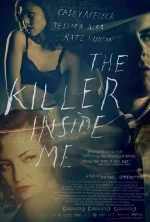Vaya Con El Diablo
2010 // USA // Robert Rodriguez and Ethan Maniquis // September 6, 2010 // Theatrical Print (St. Louis Cinemas Moolah Theater)
B- - Among the fake trailers that played in the theatrical version of the Robert Rodriguez / Quentin Tarantino joint Grindhouse, the grainy, tobacco-yellow glimpse of the Mexploitation bloodbath Machete was distinguished by how little it left to the imagination. Directed by Rodriguez himself, the trailer essentially gave us the entire plot of the film: day laborer and former federale Machete (Danny Trejo) is hired as an assassin by an American politician, is subsequently double-crossed, and then proceeds to extract a grisly revenge with his titular weapon of choice. The trailer was punchy and funny, especially the tagline ("They just fucked with the wrong Mexican!"), but it didn't exactly demand to be expanded into a feature-length film. Nonetheless, Rodriguez has done exactly that, heedless that the endeavor undermines the wry cleverness of the whole fake trailer premise. Co-directed by Ethan Maniquis, a veteran of the editing shop at Rodriguez' Troublemaker Studios, Machete necessarily loses some of its jagged pithiness when expanded to 105 minutes. Moreover, there's no getting around the fact that the film is howlingly silly in a manner not seen in any non-Spy Kids Rodriguez venture since From Dusk Till Dawn. Unlike that film, however, Machete is unswerving in its tone: balls-out cheesiness with a slathering of Latino Pride. What sets it apart from slightly more vacuous guilty pleasures (e.g. The Losers) is its languid self-awareness, its cheeky attention to detail, and its crude but timely political consciousness. It also has Michelle Rodriguez in a beret, eye-patch, and bikini top, wielding a big fucking gun. Need I say more?
It's hardly worthwhile to recount the details of the plot, given that Rodriguez characteristically disregards narrative cohesiveness, preferring to giddily string together schlocky set pieces like combo punches in a fighting game. Suffice to say that Machete finds himself targeted by a vast conspiracy encompassing a reactionary Texas state senator (Robert De Niro), his wealthy PR svengali (Jeff Fahey), a border-patrolling vigilante (Don Johnson), and the Mexican drug lord (Steven Seagal) that just happens to have slaughtered our hero's family. In Machete's corner are his shotgun-toting priest brother (Cheech Marin), an idealistic ICE agent (Jessica Alba), and the aforementioned Michelle Rodriguez as a taco truck entrepreneur waging a secret guerilla war for illegal immigrants' rights. It's Rodriguez' revolutionary—archly referred to in Guevara-inspired iconography as "She"—who rallies a network of immigrant workers to Machete's side from Texas hotel rooms, restaurant kitchens, and garden tool sheds.
Rodriguez' persistent limitations as a filmmaker are unfortunately evident in Machete. The film harbors the customary groan-worthy dialog and disharmonious, slapdash storytelling that has been the director's stock and trade for some time. The latter is all the more apparent here, as Machete bears the often harsh seams of a film written around the scenes and one-liners established in the original trailer. Nonetheless, Rodriguez remains inimitable in his ability to strike a frantic pose directly on the thin line between the satirical and the legitimately ludicrous. Machete is clearly a winking enterprise overall, but how exactly are we to take the sight of Lindsay Lohan as a revolver-packing nun, sneering out the line, "In the name of the Father—I forget the rest"? Is it intended to invite a snort of disbelief or a guffaw of guilty delight? Perhaps both?
Cheese though it might be, Machete is an unabashedly populist film, in the rough manner of the exploitation films of yore. Its politics are hardly sophisticated stuff, manifesting primarily as fist-pumping affection for the Latino underdog in the face of racist cracker bogeymen. Rodriguez makes his villains easy to hate, his heroes easy to like, and puts all the lusciously hot women in the latter category. It would be crass as hell if it weren't so lip-smackingly mindful of its crassness, or so pointedly unconcerned with gravitas. Simply put, the film doesn't contain a jot of sobriety. Even a dreadful speech from Alba that shamelessly riffs on Malcolm X is played primarily for its intrinsic goofiness.
With his sun-cracked leather visage and wildcat manner—the solid physical presence, drowsy menace, and spitting fury when riled—Trejo seems born to play Machete, even if the character proves to be little more than a badass Mystery Man. Fahey and the achingly sexy-tough Rodriguez are also highlights, but let's not perpetuate the misconception that fine acting is the primary draw here. Machete is a film about a guy who kills people with machetes (and Bowie knives, and meat cleavers, and surgical saws...), and the fact that it's executed with vitality and brazenness doesn't mitigate its inherently lowbrow nature. Indeed, there's something invigorating about a film that's such stupid-fun and also boasts so many cunning flourishes. These include subtle touches like the green-brown bruises on Lohan's forearms, as well as screamingly obvious metaphors like the crucifix built from closed-circuit security monitors. Perhaps Machete's most cutting gesture is that every character—including the film's bigoted villains—is seen wolfing down Tex-Mex cuisine with gusto, suggesting that those who rail against a cross-border incursion are already a tad behind the curve.









